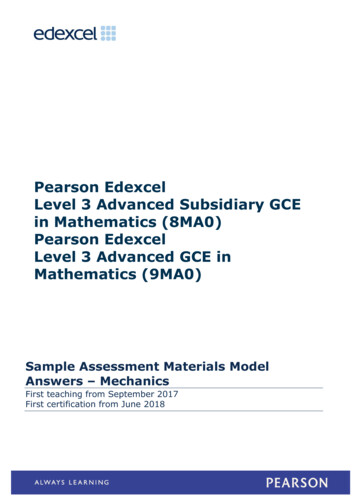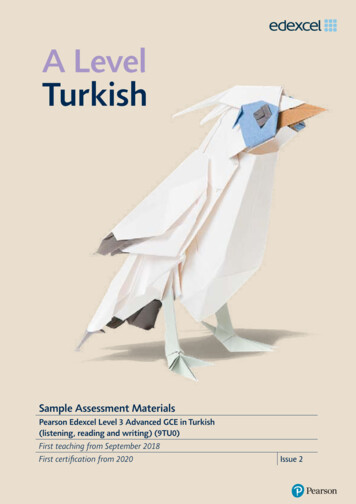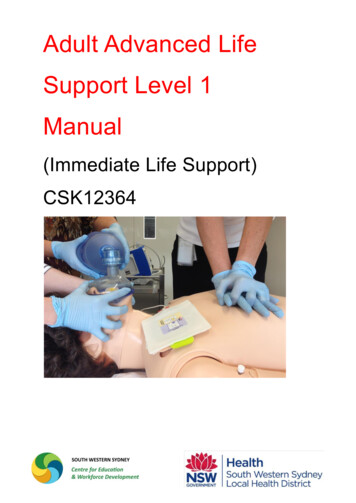
Transcription
Pearson EdexcelLevel 3 Advanced Subsidiary GCEin Mathematics (8MA0)Pearson EdexcelLevel 3 Advanced GCE inMathematics (9MA0)Sample Assessment Materials ModelAnswers – MechanicsFirst teaching from September 2017First certification from June 2018
Sample Assessment Materials Model Answers –MechanicsContentsIntroduction . 3AS Level Question 6 . 4AS level Question 7 . 6AS level Question 8 . 7AS level Question 9 . 9A level Question 6 . 12A level Question 7 . 13A level Question 8 . 15A level Question 9 . 17A level Question 10 . 202Pearson Edexcel Level 3 Advanced Subsidiary and Advanced GCE in Mathematics (8MA0 & 9MAO)Sample Assessment Materials Model Answers – Mechanics Pearson Education Limited 2017
IntroductionThis booklet has been produced to support mathematics teachers delivering the newPearson Edexcel Level 3 Advanced Subsidiary and Advanced GCE in Mathematics (8MA0 and9MA0) specifications for first teaching from September 2017.This booklet looks at Sample Assessment Materials for AS and A level Mathematicsqualifications, specifically at mechanics questions, and is intended to offer model solutions withdifferent methods explored.Content of MechanicsContentAS level contentA level contentSimple 2D situationsResolution of forces is notrequiredIn 2D situations includingfriction and resolvingforces into components1D problems or simple 2Dproblems and can includeparticles connected over apulley2D problems e.g.involving resolvingcomponents andprojectilesNot in ASEquilibrium of rigidbodies such as ladderproblemsForces in static situations in dynamic situations (usingkinematic acceleration formulae) their application to Newton’s LawsKinematics the equations of motion forconstant acceleration displacement velocity andacceleration time graphs variable acceleration problemsusing calculusMoments their applications to solving staticproblemsDynamics the accelerations as a result offorces linking back to usingkinematicsVector Techniques applied to Dynamics andKinematicsNewton’s laws of motionIncluding connectedparticles and 1D situationsNewton’s laws of motionin 2D situations includingparticles on an inclinedplaneIncluding unit vectors i and Including unit vectors i andj and column vectorsj, column vectors andequations such as v u at3Pearson Edexcel Level 3 Advanced Subsidiary and Advanced GCE in Mathematics (8MA0 & 9MAO)Sample Assessment Materials Model Answers – Mechanics Pearson Education Limited 2017
AS Level Question 6Unless otherwise indicated, whenever a numerical value of g is required, take g 9.8 m s–2 andgive your answer to either 2 significant figures or 3 significant figures.Figure 1A car moves along a straight horizontal road. At time t 0, the velocity of the car isU m s–1. The car then accelerates with constant acceleration a m s–2 for T seconds. The cartravels a distance D metres during these T seconds.Figure 1 shows the velocity-time graph for the motion of the car for 0 t T.Using the graph, show that D UT 12aT 2.(No credit will be given for answers which use any of the kinematics (suvat) formulae listedunder Mechanics in the AS Mathematics section of the formulae booklet.)(4)The area underneath a velocity – time graph represents the distance travelled.M1V4Pearson Edexcel Level 3 Advanced Subsidiary and Advanced GCE in Mathematics (8MA0 & 9MAO)Sample Assessment Materials Model Answers – Mechanics Pearson Education Limited 2017
Let the final velocity be V.The area under the graph is given by the area of the trapezium:𝐷 (𝑈 𝑉)2𝑇(1)A1The gradient of a velocity – time graph represents the acceleration:𝑎 𝑉 𝑈𝑇(2)M1Re-arranging (2)V U aTSubstitute into (1)D Expand and simplifyD UT (U U aT )T21 2aT2A15Pearson Edexcel Level 3 Advanced Subsidiary and Advanced GCE in Mathematics (8MA0 & 9MAO)Sample Assessment Materials Model Answers – Mechanics Pearson Education Limited 2017
AS level Question 7A car is moving along a straight horizontal road with constant acceleration. There are threepoints A, B and C, in that order, on the road, where AB 22 m and BC 104 m. The cartakes 2 s to travel from A to B and 4 s to travel from B to C.Find(i)the acceleration of the car,(ii)the speed of the car at the instant it passes A.(7)(i)22mA2s104mC4sBLet u m s–1 velocity at A, a m s–2 the constant acceleration.Strategy to set up twoequations in a and u1Using s ut at 22For AB: s 22, u u, t 2, a a.M1M11a 4211 u a (1)22 2u A1Now use AC rather than BC to allow a common use of u and a.For AC: s 126, u u, t 6, a a.M11126 6u a 36221 u 3a (2)A1(2) – (1)The acceleration is 5 m s–210 2aa 5A1(ii)Substitute a 5 into (1)11 u 5u 6The speed at A is 6 m s–1A1ft6Pearson Edexcel Level 3 Advanced Subsidiary and Advanced GCE in Mathematics (8MA0 & 9MAO)Sample Assessment Materials Model Answers – Mechanics Pearson Education Limited 2017
Alternative(i)As the acceleration is constant, the average speed for AB 22 11 m s–12[This corresponds to the speed at the midtime of AB i.e. t 1.]104 26 m s–14[This corresponds to the speed at the midtimeof BC i.e. t 2 2 4.]and the average speed for BC The acceleration between t 1 and t 4, a m s–2 is given by:v ua t26 11a 53The acceleration is 5 m s–2(ii)For A to the midpoint of ABUsing v u at, v 11, a 5, t 1The speed at A is 6 m s–1u 11 – 5 1u 67Pearson Edexcel Level 3 Advanced Subsidiary and Advanced GCE in Mathematics (8MA0 & 9MAO)Sample Assessment Materials Model Answers – Mechanics Pearson Education Limited 2017
AS level Question 8A bird leaves its nest at time t 0 for a short flight along a straight line.The bird then returns to its nest.The bird is modelled as a particle moving in a straight horizontal line.The distance, s metres, of the bird from its nest at time t seconds is given bys 1 4(t – 20t 3 100t 2), where 0 t 10.10(a) Explain the restriction 0 t 10.(3)Substitute both values t 0 and t 10 into s 1 4(t – 20t 3 100t 2)10M1Gives s 0 for both t 0 and t 10, which correspond with the start and end of the flight.A12The factorisation of s t t 10 2 shows that s 0 for 0 t 1010A1(b) Find the distance of the bird from the nest when the bird first comes to instantaneous rest.(6)The bird will be at rest when v 0dsv , the rate of change of distancedt1v (4t 3 – 60t 2 200t )10M1A1When at rest, v 0,1(4t 3 – 60t 2 200t ) 010M1t 3 – 15t 2 50t 0t(t2 – 15t 50) 0(t – 5)(t – 10) 0Therefore, t 0, 5, 10A18Pearson Edexcel Level 3 Advanced Subsidiary and Advanced GCE in Mathematics (8MA0 & 9MAO)Sample Assessment Materials Model Answers – Mechanics Pearson Education Limited 2017
First at intantaneous rest when t 5 (when the bird turns back) 52 5 10 2 or s 1 54 20 53 100 52When t 5, s 1010 M1125 2510Distance 62.5 m.s A1ft9Pearson Edexcel Level 3 Advanced Subsidiary and Advanced GCE in Mathematics (8MA0 & 9MAO)Sample Assessment Materials Model Answers – Mechanics Pearson Education Limited 2017
AS level Question 9A (2.5 kg)PB (1.5 kg)1mFigure 2A small ball A of mass 2.5 kg is held at rest on a rough horizontal table.The ball is attached to one end of a string.The string passes over a pulley P which is fixed at the edge of the table. The other end of thestring is attached to a small ball B of mass 1.5 kg hanging freely, vertically below P and withB at a height of 1 m above the horizontal floor.The system is released from rest, with the string taut, as shown in Figure 2.The resistance to the motion of A from the rough table is modelled as having constantmagnitude 12.7 N. Ball B reaches the floor before ball A reaches the pulley.The balls are modelled as particles, the string is modelled as being light and inextensible andthe pulley is modelled as being small and smooth.(a) (i) Write down an equation of motion for A.(ii) Write down an equation of motion for B.(4)As the pulley is smooth, the tension in the string will be the same in both parts of the string.The system will have a common acceleration, a m s–2.A has no vertical component of motion so the normal reaction, R newtons, will be equal to theweight of A.Friction (the constant resistance here) opposes motion so acts to the left.10Pearson Edexcel Level 3 Advanced Subsidiary and Advanced GCE in Mathematics (8MA0 & 9MAO)Sample Assessment Materials Model Answers – Mechanics Pearson Education Limited 2017
a m s–2RN12.7 NA (2.5kg) T NTNPTN2.5g NB (1.5kg)a m s–21m1.5g NUsing F ma(i) For AT – 12.7 2.5a(ii) For B1.5g – T 1.5aM1 A1M1 A1(b) Hence find the acceleration of B.(2)Adding (i) and (ii)1.5g – 12.7 4aM114.7 – 12.7 4a2 4aa 0.5Acceleration of B 0.5 m s– 2A1(c) Using the model, find the time it takes, from release, for B to reach the floor.(2)Using s ut 1 2at with a 0.5, u 0, s 121 0 t 1 0.5 t 22M111Pearson Edexcel Level 3 Advanced Subsidiary and Advanced GCE in Mathematics (8MA0 & 9MAO)Sample Assessment Materials Model Answers – Mechanics Pearson Education Limited 2017
11 t24t2 4t 2Time for B to reach the floor is 2 sA1It was found that it actually took 2.3 seconds for ball B to reach the floor.(d) Using this information,(i) comment on the appropriateness of using the model to find the time it takes ball B toreach the floor, justifying your answer.(ii) suggest one improvement that could be made in the model.(2)(i)The model is inappropriate because the ball has taken longer to reach the floor as the model does not include air resistance does not include the roughness of the pulleyOr because of any other appropriate reason such as: the string will have mass which will affect the tension the string may stretch which will affect the acceleration. the pulley may not be smooth which will affect the tensionB1(ii) Do not model B as a particle but give its dimensions so the distance it falls will beless. If the pulley is not modelled as small the tension in the string along the table wouldnot be horizontal (parallel to the table). Do not model the resistance as being constant.B112Pearson Edexcel Level 3 Advanced Subsidiary and Advanced GCE in Mathematics (8MA0 & 9MAO)Sample Assessment Materials Model Answers – Mechanics Pearson Education Limited 2017
A level Question 6Unless otherwise indicated, whenever a numerical value of g is required, take g 9.8 m s–2and give your answer to either 2 significant figures or 3 significant figures.At time t seconds, where t 0, a particle P moves so that its acceleration a m s 2 is given by1a 5t i – 15t 2 jWhen t 0, the velocity of P is 20i m s 1Find the speed of P when t 4(6)Rate of change of velocity accelerationdvTherefore adtv a dtHenceM112v 5t i 15t j dt322v 5t15ti j c322A132v 2.5t 2 i 10t j cTo find the constant vector c, use v 20i when t 0c 20i 3v 2.5t 2 20 i 10t 2 jTherefore,A132v 2.5 16 20 i 10 4 jv 60i – 80jWhen t 4M1Speed is the magnitude of the velocity vectorv 60 2 80 2 3600 6400 10000Speed 100 m s–1M1A1ft13Pearson Edexcel Level 3 Advanced Subsidiary and Advanced GCE in Mathematics (8MA0 & 9MAO)Sample Assessment Materials Model Answers – Mechanics Pearson Education Limited 2017
A level Question 7A rough plane is inclined to the horizontal at an angle , where tan 3.4A particle of mass m is placed on the plane and then projected up a line of greatest slope ofthe plane.The coefficient of friction between the particle and the plane is µ.The particle moves up the plane with a constant deceleration of4g.5(a) Find the value of µ.(6)μμtanα ¾aRWhen the angle is given as a trig ratio, use aright-angled triangle to find the other ratios:mgsinααF mgcosαmg5sinα 3/5cosα 4/53α4The weight mg can be resolved into two components one parallel to and one perpendicular tothe plane mgsinα and mgcosα as shown above.Let the normal reaction to the plane be R and the force due to friction be F.Then, resolving perpendicular to the plane;R mgcosαB14R mg (1)5Using F ma parallel to the plane:M14F mgsinα mg5A1F 34mg mg5514Pearson Edexcel Level 3 Advanced Subsidiary and Advanced GCE in Mathematics (8MA0 & 9MAO)Sample Assessment Materials Model Answers – Mechanics Pearson Education Limited 2017
F 1mg (2)5For friction, F μR. Since the particle is moving, F has reached its maximum value soF μRM1μ Or,FRM1Hence, dividing (2) by (1)1mg1μ 5 44mg5A1The particle comes to rest at the point A on the plane.(b) Determine whether the particle will remain at A, carefully justifying your answer.(2)Once the particle stops moving up the plane, friction will act up the plane trying to prevent theparticle moving back down the plane.The particle will move back down the plane if the component of the weight of the particle downthe plane exceeds the maximum force of friction.M13Component of weight down the plane:mgsinα mg5Maximum force of friction:F μR1 4 mg4 51F mg5F Hence the particle will move back down the plane as31m mg55A115Pearson Edexcel Level 3 Advanced
This booklet looks at Sample Assessment Materials for AS and A level Mathematics qualifications, specifically at mechanics questions, and is intended to offer model solutions with different methods explored. Content of Mechanics Content AS level content A level content Forces Simple 2D











